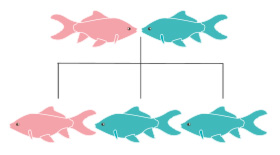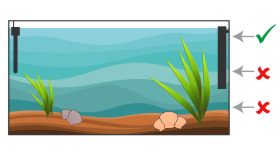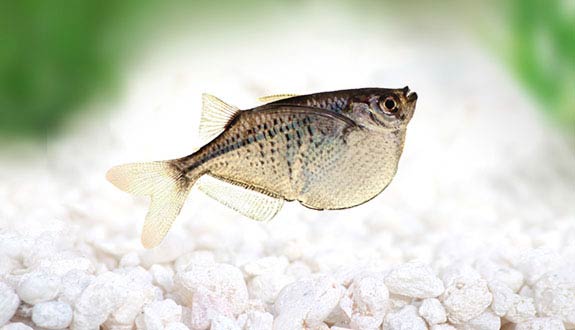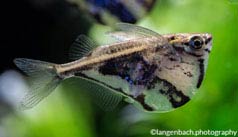

Alternative species (click on the thumbnail to see the card)
Names
Scientific name
Gasteropelecus sternicla
Gasteropelecus argenteus
Gasteropelecus coronatus / marowini
Gasteropelecus sternicla morae
Salmo gasteropelecus
Common name
Common Hatchetfish
River hatchetfish
Origin

Origin: Brazil, Colombia, Guyana, French Guiana, Peru, Suriname, Venezuela
Biotope: Amazonian
Dimorphism

None
Group

Gasteropelecidae
Volume

120 L / 26 imp gal / 32 US gal
Parameters

T°: 23 to 27°C or 73 to 81°F
pH: 5 to 8
Hardness: 2 to 10°dGH
Difficulty

Average
Size

4 à 6.5cm (1.6 to 2.6")
Longevity

4 years
Living zone

Top
Individuals

8
Food
How to feed the Common Hatchetfish?
Food
How to feed the Common Hatchetfish?
Carnivorous with insectivorous tendency (attention to the size of prey, quite small): zooplankton, drosophila, mosquito larvae, small cockroaches, crickets, chironomids, daphnia.
Note that it eats mainly on the surface.
Behavior
What kind of behavior does the Common Hatchetfish have?
Behavior
What kind of behavior does the Common Hatchetfish have?
With a fairly lively temperament, it can sometimes even be aggressive with its congeners. It is gregarious and must imperatively be kept in a shoal. Especially for a hatchet fish, you will sometimes observe this species leave the surface to go down a little. In this area, it can feed, interact with other hatchet fish, or sometimes it will just stay still at this place.
Cohabitation
Who can live with the Common Hatchetfish?
Cohabitation
Who can live with the Common Hatchetfish?
As it is a surface fish, it will be able to live in a community aquarium, even if a specific aquarium is preferable considering its reserved nature. It can therefore be associated with a lot of species (not too big) without the risk of dispute of territory.
However, favor roommates who do not use the same area of life as him, such as dwarf Cichlids, small Characidae (Tetra, neon blue...) or Corydoras.
Breeding
How to breed the Common Hatchetfish?
Breeding
How to breed the Common Hatchetfish?
Like the marbled hatchet fish, breeding is difficult. You will have a better chance of succeeding with a large group. Install the spawning tank (100 L / 22 imp gal / 26 US gal) with a protective grid, a lid and many floating plants. Also, plan for good water circulation. Temperature 25°C or 77°F and pH 6.5/7, without carbonates, and diffuse lighting. Peat filtration would be a plus.
Remove the parents after laying. The incubation lasts 36 hours.
Feeding fry: infusoria, rotifers, then nauplies of artemia and cyclops.
Its aquarium
Which aquarium for the Common Hatchetfish?
Its aquarium
Which aquarium for the Common Hatchetfish?
A specific aquarium is preferable. The essential element will be the presence of many surface plants. The rest of the decoration does not matter much. It seems, however, that this fish feels more comfortable in the luxurious aquariums and Amazonian biotope. Ideally, you will opt for a sand substrate. Peat filtration is recommended and must be powerful enough (good oxygenation and nitrates at the lowest).
Finally, you can add a few dried leaves that will make excellent bacterial media and improve water chemistry. Above all, cover your aquarium because like the majority of insectivores, the hatchet fish is an excellent jumper (be careful when changing water, and protect the lighting ramp with a fine mesh net). Another solution is to fill the aquarium only partially and to leave 25/30 cm (10-12 inches) between the surface of the water and the lid. Finally, be careful not to make too much current on the surface.
Good To know
Find all additional information!
Good To know
Find all additional information!
A group will establish a definite hierarchy. Thus, when it is necessary, some parries or small games will restore the order within the shoal.
Yours photos!
Comments
Sort by:
Please login to post comments


